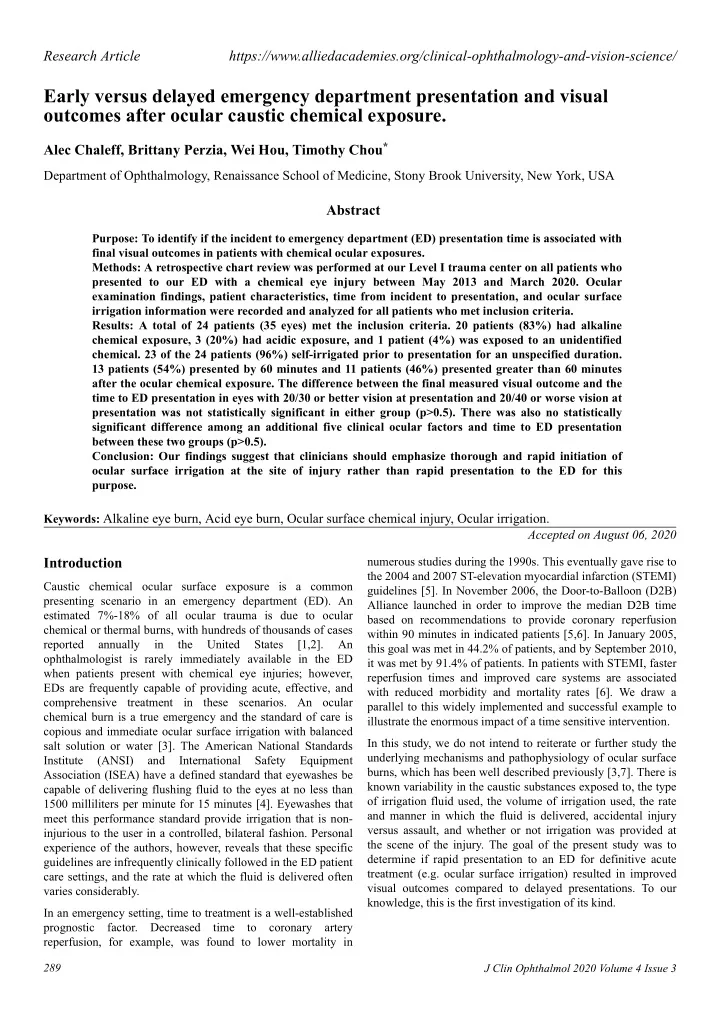

Research Article https://www.alliedacademies.org/clinical-ophthalmology-and-vision-science/ Early versus delayed emergency department presentation and visual outcomes after ocular caustic chemical exposure. Alec Chaleff, Brittany Perzia, Wei Hou, Timothy Chou * Department of Ophthalmology, Renaissance School of Medicine, Stony Brook University, New York, USA Abstract Purpose: To identify if the incident to emergency department (ED) presentation time is associated with final visual outcomes in patients with chemical ocular exposures. Methods: A retrospective chart review was performed at our Level I trauma center on all patients who presented to our ED with a chemical eye injury between May 2013 and March 2020. Ocular examination findings, patient characteristics, time from incident to presentation, and ocular surface irrigation information were recorded and analyzed for all patients who met inclusion criteria. Results: A total of 24 patients (35 eyes) met the inclusion criteria. 20 patients (83%) had alkaline chemical exposure, 3 (20%) had acidic exposure, and 1 patient (4%) was exposed to an unidentified chemical. 23 of the 24 patients (96%) self-irrigated prior to presentation for an unspecified duration. 13 patients (54%) presented by 60 minutes and 11 patients (46%) presented greater than 60 minutes after the ocular chemical exposure. The difference between the final measured visual outcome and the time to ED presentation in eyes with 20/30 or better vision at presentation and 20/40 or worse vision at presentation was not statistically significant in either group (p>0.5). There was also no statistically significant difference among an additional five clinical ocular factors and time to ED presentation between these two groups (p>0.5). Conclusion: Our findings suggest that clinicians should emphasize thorough and rapid initiation of ocular surface irrigation at the site of injury rather than rapid presentation to the ED for this purpose. Keywords: Alkaline eye burn, Acid eye burn, Ocular surface chemical injury, Ocular irrigation. Accepted on August 06, 2020 Introduction numerous studies during the 1990s. This eventually gave rise to the 2004 and 2007 ST-elevation myocardial infarction (STEMI) Caustic chemical ocular surface exposure is a common guidelines [5]. In November 2006, the Door-to-Balloon (D2B) presenting scenario in an emergency department (ED). An Alliance launched in order to improve the median D2B time estimated 7%-18% of all ocular trauma is due to ocular based on recommendations to provide coronary reperfusion chemical or thermal burns, with hundreds of thousands of cases within 90 minutes in indicated patients [5,6]. In January 2005, reported annually in the United States [1,2]. An this goal was met in 44.2% of patients, and by September 2010, ophthalmologist is rarely immediately available in the ED it was met by 91.4% of patients. In patients with STEMI, faster when patients present with chemical eye injuries; however, reperfusion times and improved care systems are associated EDs are frequently capable of providing acute, effective, and with reduced morbidity and mortality rates [6]. We draw a comprehensive treatment in these scenarios. An ocular parallel to this widely implemented and successful example to chemical burn is a true emergency and the standard of care is illustrate the enormous impact of a time sensitive intervention. copious and immediate ocular surface irrigation with balanced In this study, we do not intend to reiterate or further study the salt solution or water [3]. The American National Standards underlying mechanisms and pathophysiology of ocular surface Institute (ANSI) and International Safety Equipment burns, which has been well described previously [3,7]. There is Association (ISEA) have a defined standard that eyewashes be known variability in the caustic substances exposed to, the type capable of delivering flushing fluid to the eyes at no less than of irrigation fluid used, the volume of irrigation used, the rate 1500 milliliters per minute for 15 minutes [4]. Eyewashes that and manner in which the fluid is delivered, accidental injury meet this performance standard provide irrigation that is non- versus assault, and whether or not irrigation was provided at injurious to the user in a controlled, bilateral fashion. Personal the scene of the injury. The goal of the present study was to experience of the authors, however, reveals that these specific determine if rapid presentation to an ED for definitive acute guidelines are infrequently clinically followed in the ED patient treatment (e.g. ocular surface irrigation) resulted in improved care settings, and the rate at which the fluid is delivered often visual outcomes compared to delayed presentations. To our varies considerably. knowledge, this is the first investigation of its kind. In an emergency setting, time to treatment is a well-established prognostic factor. Decreased time to coronary artery reperfusion, for example, was found to lower mortality in 289 J Clin Ophthalmol 2020 Volume 4 Issue 3
Recommend
More recommend